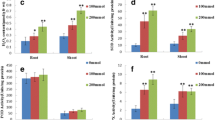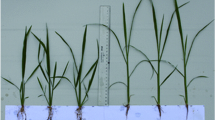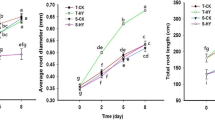Abstract
Nitrogen fertilization is essential for increasing rice production to meet the food demands of increasing world’s population. We established an in vivo hydroponic rice seedling culture system to investigate physio-biochemical/molecular responses of various rice japonica and indica cultivars to low nitrogen (N). Three-week-old seedlings grown in Yoshida’s nutrient solution manifested stable and reproducible symptoms, such as reduced shoot growth and length under low N. Out of 12 genetically selected cultivars, 11 cultivars showed varied degrees of growth reduction response to applied N (4 and 40 ppm N for treatment and control, respectively), whereas one cultivar (no. 12) showed similar growth as the control though its leaf width was smaller than control. Leaves of a representative low N-responsive cultivar (BG90-2) were sampled for revealing protein profiles between low and normal (control) N application by two-dimensional gel electrophoresis (2-DGE). Forty-one proteins were identified with MALDI-TOF-MS and nESI-LC-MS/MS. Assignment of proteins into major (energy metabolism, photosynthesis and oxidative stress) and minor functional categories, revealed many novel low N-responsive proteins, including those having energy/photosynthesis- and defense/stress- and iron homeostasis-related functions. Results suggest the usefulness of proteomics in identifying novel N-responsive proteins and may provide potential markers for rice response to low N.
Similar content being viewed by others
Abbreviations
- APX:
-
Ascorbate peroxidase
- CHAPS:
-
3-[(3-cholamidopropyl) dimethylaminol]-1-propanesulfonate
- DTT:
-
dithiothreitol
- LSU:
-
Large subunit
- SOD:
-
Superoxide dismutase
- SSU:
-
Small subunit
Literature Cited
Agrawal GK and Rakwal R (2006). Rice proteomics: a cornerstone for cereal food crop proteomes. Mass Spectrom. Rev. 25: 1–53
Agrawal GK, Rakwal R, Yonekura M, Kubo A and Saji H (2002). Proteome analysis of differentially displayed proteins as a tool for investigating ozone stress in rice (Oryza sativa L.) seedlings. Proteomics 2: 947–959
Agrawal GK, Yonekura M, Iwahashi Y, Iwahashi H and Rakwal R (2005a). System, trends and perspectives of proteomics in dicot plants Part I: Technologies in proteome establishment. J. Chromatogr. B Analyt. Technol. Biomed. Life Sci. 815: 109–123
Agrawal GK, Yonekura M, Iwahashi Y, Iwahashi H and Rakwal R (2005b). System, trends and perspectives of proteomics in dicot plants Part II: Proteomes of the complex developmental stages. J. Chromatogr. B Analyt. Technol. Biomed. Life Sci. 815: 125–136
Agrawal GK, Yonekura M, Iwahashi Y, Iwahashi H and Rakwal R (2005c). System, trends and perspectives of proteomics in dicot plants. Part III: Unraveling the proteomes influenced by the environment, and at the levels of function and genetic relationships. J. Chromatogr. B Analyt. Technol. Biomed. Life Sci. 815: 137–145
Broadbent EE, De Datta SK and Laureles EV (1987). Measurement of nitrogen utilization efficiency of rice genotypes. Agron. J. 79: 786–791
Cui S, Huang F, Wang J, Ma X, Cheng Y and Liu J (2005). A proteomic analysis of cold stress responses in rice seedlings. Proteomics 5: 3162–3172
Goto F, Yoshihara T, Shigemoto N, Toki S and Takaiwa F (1999). Iron fortification of rice seed by the soybean ferritin gene. Nat. Biotechnol. 17: 282–286
Hoai NTT, Shim IS, Kobayashi K and Usui K (2003). Accumulation of some nitrogen compounds in response to salt stress and their relationship with salt tolerance in rice (Oryza sativa L.) seedlings. Plant Growth Regul. 41: 159–164
Kim DW, Rakwal R, Agrawal GK, Jung YH, Shibato J, Jwa NS, Iwahashi Y, Iwahashi H, Kim DH, Shim IS and Usui K (2005). A hydroponic rice seedling culture model system for investigating proteome of salt stress in rice leaf. Electrophoresis 26: 4521–4539
May MJ, Vernoux T, Leaver C, Van Montagu M and Inze D (1998). Glutathione homeostasis in plants: implications for environmental sensing and plant development. J. Exp. Bot. 49: 649–667
Molik S, Karnauchov I, Weidlich C, Herrmann RG and Klosgen RB (2001). The Rieske Fe/S protein of the cytochrome b6/f complex in chloroplasts: missing link in the evolution of protein transport pathways in chloroplasts? J. Biol. Chem. 276: 42761–42766
Oh MK, Kim MY, Choi MK, Choi IS, Cho YC, Kim YG, Lee JH and Lee YT (2005). Genotypic Differences in Nitrogen Uptake and Utilization for Grain Yield of Rice. Korean J. Breeding 37: 209–213
Park OK (2004). Proteomic studies in plants. J. Biochem. Mol. Biol. 37: 133–138
Rakwal R, Agrawal GK, Kubo A, Yonekura M, Tamogami S, Saji H and Iwahashi H (2003). Defense/stress responses elicited in rice seedlings exposed to the gaseous air pollutant sulfur dioxide. Environ. Exp. Botany 49: 223–235
Scandalios JG (2002). The rise of ROS. Trends Biochem. Sci. 27: 483–486.
Singh U, Cassman KG, Ladha JK and Bronson KF (1995) In: Innovative nitrogen management strategies for lowland rice systems, Fragile lives in fragile ecosystems. International Rice Research Institute, Manila, Philippines, pp. 786–791
Sugihara K, Hanagata N, Dubinsky Z, Baba S and Karube I (2000). Molecular characterization of cDNA encoding oxygen evolving enhancer protein 1 increased by salt treatment in the mangrove Bruguiera gymnorrhiza. Plant Cell. Physiol. 41: 1279–1285
Von Uexkull HR (1993). New trend in rice crop production enhancement of nutrient use efficiency. In: New Frontiers in Rice Research (Eds. Muralidharan, K. and Siddig, E.A.), Directorate of Rice Research, Hyderabad 500030, India, pp. 290–299
Wingler A, Lea PJ, Quick WP and Leegood RC (2000). Photorespiration: metabolic pathways and their role in stress protection. Philos. Trans. R. Soc. Lond. B Biol. Sci. 355: 1517–1529
Author information
Authors and Affiliations
Corresponding author
Rights and permissions
About this article
Cite this article
Kim, D.H., Shibato, J., Kim, DW. et al. Gel-based proteomics approach for detecting low nitrogen-responsive proteins in cultivated rice species. Physiol Mol Biol Plants 15, 31–41 (2009). https://doi.org/10.1007/s12298-009-0003-0
Published:
Issue Date:
DOI: https://doi.org/10.1007/s12298-009-0003-0




